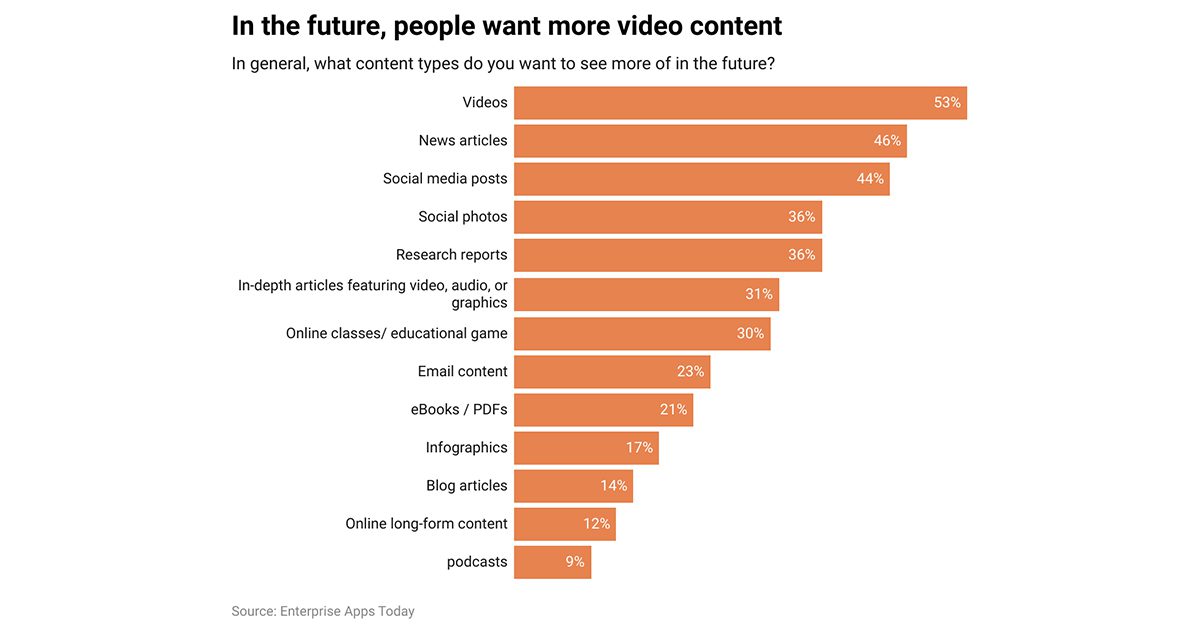Every dollar counts when it comes to small business marketing. Digital marketing allows for precise targeting and analytics, so businesses know exactly where their money is going and what results it’s bringing in. With digital marketing accounting for such a significant portion of small businesses’ marketing efforts, having a strategy for the content you produce is incredibly important.
A content strategist is the person behind the content operations of a business or organization. Their main job is to plan, develop, and manage content that aligns with the company’s goals and users’ needs. They are the person who makes sure the content not only sounds good but also serves a purpose, whether that’s to inform, entertain, or convert audiences.
Their work involves a lot of research and analysis to understand what kind of content performs well with the target audience and why. They’re always looking into data to see what’s hitting the mark and what’s not. From there, they create strategies that might include blogs, social media posts, emails, and more, ensuring everything is SEO-friendly so users can find what they’re looking for online.
Read on for some important skills and responsibilities of this crucial marketing role.
What is Content Marketing?

Content marketing is the process of creating and sharing valuable, relevant, and consistent content to attract and retain a clearly defined audience—and, ultimately, to drive customer conversions. Content marketing includes a combination of multiple formats, such as blog posts, videos, podcasts, infographics, and social media posts.
Content marketing is less about “buy our stuff” messaging and more about offering insightful and helpful content to users. The idea is to establish expertise, promote brand awareness, and keep your business top of mind when it’s time for the consumer to make a purchase. It’s a way to build a relationship with your audience without directly pushing sales, making them more likely to choose your product or service because they trust your brand.
Content marketing works because it helps people find information and make purchasing decisions. Think about the type of information you consume online. If you’re like most people, you’re looking online for answers to your questions, solutions to your problems, or simply something that entertains or informs.
Businesses that can provide that content to readers aren’t just selling something; they’re becoming a valued resource. When content marketing is done right, it can significantly boost a brand’s credibility, increase visibility, and attract more engaged prospects.
What Does Content Strategy Mean?
Content marketing strategy is the process of planning, developing, and managing content to align with business goals, understanding audience needs, and creating purposeful, consistent, and effective communication.
Content strategy includes:
- understanding the audience
- setting clear goals
- creating high-value content
- tailoring brand voice and messaging
- optimizing for SEO
- measuring and analyzing content
- refining the strategy
What Makes an Effective Content Strategy?
An effective content strategy is:
- dynamic and responsive (always changing according to the needs of the consumer)
- driven by a deep understanding of the target audience
- aligned with clear business goals
Additionally, technical aspects like keyword research and SEO are important to ensure the content reaches its intended audience.
What Does a Content Strategist Do?
A content strategist builds a brand’s communication strategy by researching and understanding the audience, planning content that aligns with business goals, integrating SEO, and analyzing performance. They make sure all content is consistent while collaborating with other team members and staying updated on trends to refine the strategy.
A good content strategist ensures each piece of content not only resonates with the audience but also contributes towards achieving the overall business goals.
They Bridge the Gap Between Business Goals and Audience Needs
A content strategist must have a deep understanding of the company’s objectives—is it boosting sales, enhancing brand awareness, or establishing thought leadership? They also need to have a deep understanding of the audience’s needs, challenges, questions, and content consumption habits.
They use that information to create a content plan that speaks directly to the audience’s needs while guiding them toward taking an action that aligns with the business’s goals. They are responsible for ensuring every piece of content, whether it’s a blog post, video, or social media update, serves a dual purpose: to provide value to the audience and to contribute to achieving the company’s objectives.
They Are Brand Storytellers
A good content strategist understands the power of storytelling in creating emotional connections with the audience. They create stories that are relatable, authentic, and engaging; they draw the audience into the brand’s world, making them feel a part of something bigger. They’re able to clearly communicate what a brand does and why it matters, and build a strong emotional bond with the audience.
They Coordinate Multi-Channel Content Distribution
Another important part of a content strategist’s job is to make sure each content distribution channel is coordinated and puts out the right message. For example, a content strategist knows that Instagram followers might expect something different from email subscribers or website visitors. They tailor content to fit the format and tone of each platform while keeping the overall message consistent.
Core Skills of a Content Strategist

A content strategist should have a mix of skills, including strong research and analytical skills to understand audience needs and industry trends. However, they also need exceptional writing and storytelling skills to create content that resonates with the target audience.
They should be strategic thinkers who can develop and implement effective content strategies aligned with business goals. SEO knowledge and proficiency with analytics tools are also important for optimizing content and measuring its impact.
Additionally, they need strong communication and collaboration skills in order to work effectively with different team members in the organization.
Strategic Thinking and Planning Abilities
A content strategist has to be able to think ahead and develop strategies that are aligned with business goals. They need to understand the target audience, market trends, and digital content creation, and plan accordingly, anticipating challenges that may arise along the way.
Content Management and Editorial Skills
A content strategist needs a solid foundation in both content management and editorial skills. They should be able to create a strategic plan that aligns with business goals and resonates with the target audience.
They need strong organizational skills in order to manage editorial calendars and ensure timely and consistent content delivery. Strong writing and editing skills are a must for someone with the job title content strategist in order to produce engaging, high-quality content.
Proficiency in Analytics and Performance Measurement
A good content strategist has to have a strong understanding of analytics and be able to analyze user engagement metrics to maintain a successful content strategy. They need to be able to measure how well content is performing against specific goals, such as increasing engagement, driving traffic, or generating leads.
To inform their decisions, they may look at data such as:
- website traffic metrics like page views, traffic sources, and unique visitors
- engagement metrics such as bounce rate and pages per session
- conversion data
- social media metrics such as likes, shares, and follower growth
- SEO data such as keyword rankings, click-through rates, and rank on search engine results pages (SERPs)
Technical Expertise and Adaptability
Content strategists need technical expertise to stay ahead of trends and implement the most effective tactics across various platforms. Managing content marketing campaigns well requires being comfortable with new technologies, tools, and software and continuously adapting strategies based on audience behavior.
Collaboration and Project Management Skills
Content strategists work closely with cross-functional teams, from creatives to developers, to effectively execute content strategies. They need strong collaboration skills to communicate their ideas and align everyone toward common goals. The role also involves project management experience, including establishing timelines, delegating tasks, and meeting deadlines.
Understanding of SEO
An effective content strategist must have a strong understanding of Search Engine Optimization (SEO) and its relationship to content marketing. This includes keyword research, on-page optimization, and developing strategies for increasing organic traffic to the website.
Creativity and Innovation
Finally, and possibly most importantly, a successful content strategist must be creative and innovative in their approach. In the age of social media content where it seems every brand is trying their best to one-up the competition, they have to be outside-the-box thinkers and find new ways to engage and connect with the target audience.
Responsibilities of a Content Strategist

Every content strategist’s job description will be different based on the company and its unique needs, but there are a few things that are common across the job.
Developing Comprehensive Content Plans
A content strategist’s main role is to create a plan to drive the brand’s content efforts, aligning with business goals through marketing strategies. A content strategist looks at the big picture, asking the right questions to ensure every piece of content has a purpose and fits into a larger strategy that drives toward specific objectives.
Overseeing the Content Creation and Curation Processes
A content strategist ensures that every piece of content, whether it’s newly created or built from existing resources, aligns with the audience’s expectations and the brand’s voice. They are responsible for guiding the tone and style of the content to make sure it engages the audience in the right ways.
If you follow a brand on social media that usually puts out content in a professional tone of voice and all of a sudden they’re posting satire and crude memes, you’d likely be confused and wonder if they got hacked. A content strategist balances original ideas with consistency in tone and brand voice.
Continuous Improvement Based on Performance Analytics
Managing content creation without any analytics to guide the strategy is the perfect example of “flying blind.” Without analytics (and a strong understanding of how to interpret them), businesses are throwing content out into the digital world with no understanding of what’s working and what isn’t. Analyzing content marketing data is one of the most important parts of a content strategist job description.
Coordinating Multi-Channel Distribution Strategies
When a content strategist looks at multi-channel distribution, they’re laying out a plan to spread content across different platforms. They need to make sure the brand’s voice stays the same, but also tweak things so they fit the platform, whether it’s on social media, in an email, or on a blog.
They figure out the best places and times to post to make sure the message not only gets out but also resonates with the people reading it.
Collaborating With Other Teams
A content strategist works closely with other teams, including marketing, sales, and product development. They align their content strategy with these departments to ensure consistent messaging and goals across the organization.
Content strategists can benefit from establishing feedback loops with sales departments and other key stakeholders. Sales teams can provide valuable insights into the needs and preferences of new and existing customers, which can significantly influence the content creation and curation processes.
Staying Current with Industry Trends and Best Practices
In the fast-moving world of content, staying still is falling behind. A content strategist has to be able to keep up with the latest trends and best practices, from new content formats and platforms to evolving SEO tactics.
This means they’re always on the lookout, learning and adapting to what’s new in the digital space. Whether it’s the rise of a new social media platform, changes in Google’s algorithm, or the latest in content creation tools, a content strategist needs to be ahead of the game.
Driving Innovation and Creativity
Innovation and creativity are the heart of good content. A great content strategist is always looking for new and creative ways to engage their audience. They may use the latest technologies, new storytelling formats, or unique angles on familiar topics to push boundaries to keep content exciting.
Tools and Technologies Used by Content Strategists

Content Management Systems (CMS)
Content Management Systems are software platforms that simplify the process of creating, managing, and publishing digital content. They allow users to add, edit, and manage website content like text, images, and videos.
An organization’s content management system separates the content creation process from the website’s backend coding, making it easy for non-developers to update and maintain websites. This means a content strategist can change the things without needing expert knowledge in web development.
Most CMS platforms come with features such as templates for web design, plugins or extensions for added functionality, and tools for SEO to help improve the site’s visibility in search engines. They also typically offer various user roles and permissions that allow multiple users to contribute to and edit content according to their access levels. This is particularly beneficial for someone like a senior content strategist who has a team working underneath them.
Analytics and SEO Tools for Content Optimization
Since content strategists rely heavily on data analysis to ensure their strategies are effective, they may rely heavily on tools like Google Analytics, Ahrefs, and SEMrush that offer insights into user metrics and search engine performance.
They track metrics like page views, time spent on a page, bounce rate, and conversion rates, which allows a content strategist to see what resonates most with their audience. SEO tools help identify the right keywords to target, analyze backlinks, and track a site’s ranking for specific search terms.
Collaboration and Project Management Software
Tools like Trello, Asana, and Slack help facilitate collaboration between the content strategy team, creative professionals, and other departments. They help plan ongoing and upcoming projects, set deadlines, and track progress to ensure everyone involved in the content creation is in alignment.
Educational Background and Training
Traditionally, degrees in fields like Marketing, Communications, Journalism, English, or Business are common starting points for someone who wants to become a content strategist. These degree programs provide a solid foundation in technical writing, critical thinking, and strategic planning.
Degrees or coursework in Digital Media, Information Technology, or even Graphic Design are also valuable, as they offer insights into the online spaces where content strategists work.
College Degrees
The education landscape is evolving just as quickly as digital technology evolves. The rapid changes in digital marketing and content creation means that practical skills and up-to-date knowledge are often more vaulable than formal education. Many employers value experience, a proven track record, and a portfolio of work just as highly, if not more so, than a specific degree.
Lifelong Learning
The digital landscape and the skills required to navigate it successfully are constantly changing. Content strategists must embrace continuous learning and professional development to remain relevant in their field.
Whether it’s keeping up with the latest changes in Google’s algorithm, exploring new content management systems, or experimenting with emerging social media platforms, ongoing professional development ensures that content strategies remain successful in their roles.
Emerging Changes to Content Strategy in 2024
The digital age has transformed how audiences consume content, and content strategy is changing rapidly in response to changes in technology, consumer behavior, and marketing practices.
We’re seeing a shift towards incorporating user-generated content, balancing personalization with privacy, and evolving SEO practices to match search engine advancements. These changes are aimed at creating more engaging, relevant, and user-focused content strategies.
AI and Automated Content Creation
AI and automated content creation tools in digital marketing are reshaping the content strategist job description, and how content strategists use automated tools can make a significant difference in the quality of their content marketing strategy.
AI can generate content quickly, handling repetitive tasks or creating basic drafts that content strategists can refine. This frees up time for strategists to focus on more complex and creative aspects of their work. Automated tools can also analyze large volumes of data to identify trends, preferences, and content performance, which provides content strategists with insights to inform their strategies.
However, AI and automated content creation tools are fairly new and come with challenges, too. AI can still struggle with creating content that matches the quality of human writers, and incorrect or poorly generated AI content can weaken trust in online audiences. Readers are more likely to connect with content through personal experiences, opinions, and storytelling that can’t be replicated by AI. If the content feels too generic, lacks personality, or misses the mark on human emotion, audiences can feel disconnected and less likely to engage with future content.
Voice Search and Other Next-Gen SEO Strategies
Voice search and next-generation SEO strategies are also making significant changes to how we approach content creation and optimization. Voice searches tend to be more conversational and longer than text queries, so new content needs to include long-tail keywords and a natural writing style that reflect how people actually talk.
Content strategists who can adapt to changes in SEO strategies are more likely to succeed in reaching their target audiences.
Video and Interactive Content
Video is the new leader in content creation. It’s engaging, easy to consume, and can be shared across various platforms. A recent report by SocialPilot shows that more than half of online users want to see more video content in the future.

While traditional blog posts and articles remain relevant, adding video content into a business’s content creation strategy can significantly increase engagement. This could include how-to videos, product demonstrations, customer testimonials, or behind-the-scenes sneak peeks.
Challenges Faced by Content Strategists
Because of how quickly and how frequently the digital landscape changes (Google launched 9 algorithm updates in 2023 alone) and the overwhelming amount of time users spend online and on their social media accounts, content strategists are tasked with constantly coming up with new and engaging content that not only catches the attention of users, but also still aligns closely with business objectives.
Keeping Up With Rapidly Changing Digital Landscapes
Here are some tips for how a content marketing strategist can keep up with all the changes in the digital landscape:
- Stay Informed: Follow industry blogs, podcasts, and webinars from leading content marketing and SEO platforms to stay up-to-date with the latest trends, algorithm updates, and best practices.
- Utilize Analytics: Use analytics tools to monitor content performance and user behaviors
- Experiment with New Formats: Be open to experimenting with new content formats and technologies to see what resonates with your audience.
- Focus on User Experience: Keep the end-user in mind, making sure you understand and can anticipate changes in user expectations as technology evolves.
Managing Content Overload and Dwindling Attention Spans
How can content strategists cut through all the digital noise and keep their audiences engaged? Here are some tips to consider:
- Quality Over Quantity: Focus on creating high-quality, valuable content that addresses the specific needs and questions of your audience rather than putting out large volumes of content that isn’t helpful or impactful.
- Be Concise: Break down complex ideas into digestible pieces, use bullet points, and include summaries to make content more accessible.
- Use Engaging Formats: Utilize formats that naturally engage users, such as videos, infographics, and interactive content to convey information succinctly and hold your user’s attention.
- Personalize Content: Utilize data and analytics to understand your audience and personalize content to their interests and behaviors.
- Optimize for Mobile: The majority of users access content on their mobile devices, so make sure your content is mobile-friendly with fast loading times, responsive design, and easy-to-read formats.
- Encourage Interaction: Create content that encourages interaction, such as quizzes or polls to increase engagement and boost time spent with your content.
- Frequent Testing and Feedback: Regularly test different types of content, formats, and strategies to see what resonates most with your audience. Use analytics to track engagement and gather feedback.
What Does the Future of Content Strategy Look Like?

One thing’s for certain: content marketing strategies will continue changing rapidly in the coming years. Advancements in AI and machine learning will enable content to be more personalized than ever before. Content strategists will need to leverage data to tailor content to users’ individual preferences and behaviors in order to generate leads and capture the attention of their audience. Augmented Reality (AR) and Virtual Reality (VR) will offer new ways to engage audiences, so content strategists should explore creative ways to incorporate AR and VR into their content plans.
With growing concerns about privacy, data security, and misinformation, content strategists will need to continue prioritizing ethical practices. This includes being transparent about data use, respecting user privacy, and ensuring content accuracy and reliability.
While we may not know the details of what’s to come, we do know that content strategists will need to be adaptable, creative, and strategic. They’ll need to embrace new tools and platforms to create meaningful, engaging content that resonates with diverse audiences.







